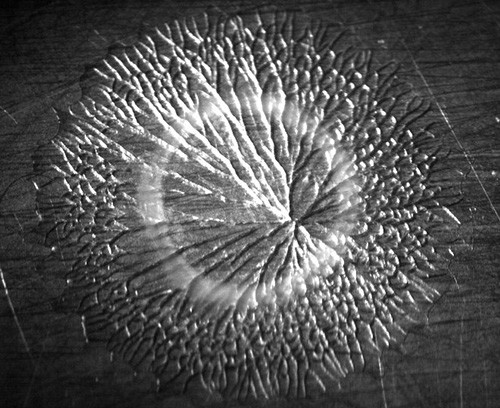
(Courtesy: E Ghabache et al./Phys. Rev. Lett.)
By Tushna Commissariat
Drops of water normally tend to splash when they strike a surface. But what happens if they hit something very cold? It turns out they first freeze and then crack, forming intricate fracture patterns, one of which you can see in the image above.
It was taken using a high-speed camera by Christophe Josserand, Thomas Séon and colleagues at the Jean Le Rond d’Alembert Institute in France. They watched water solidifying as it dripped onto a stainless-steel surface cooled to various temperatures between 0 and −60 °C (Phys. Rev. Lett. 117 074501). Due to the contact between the drop and the surface, the water’s ability to freeze is limited and mechanical stress makes it fracture in a few milliseconds.
The team found three temperature-dependent fracture regimes: no cracks; many small cracks all originating from a single point; and hierarchical fractures. The latter are larger cracks in a chequerboard pattern. The three images below are from each regime, with temperatures at –20, –40 and –60 °C respectively, from left to right.
By using classical scaling laws, Séon and colleagues conclude that the temperature-fragmentation trend arises from the balance between the thickness of the frozen drop, which decreases with surface temperature, and the minimum size of a fragment. The work could prove very useful because many natural and industrial processes – from cooling magma to drying ceramic glazes – involve a rapidly cooling material that fragments and researchers keen to predict the dynamics of this phenomenon.

Guidelines
Show/hide formatting guidelines
this text was deletedwhere people live in harmony with nature and animals</q>
Some text